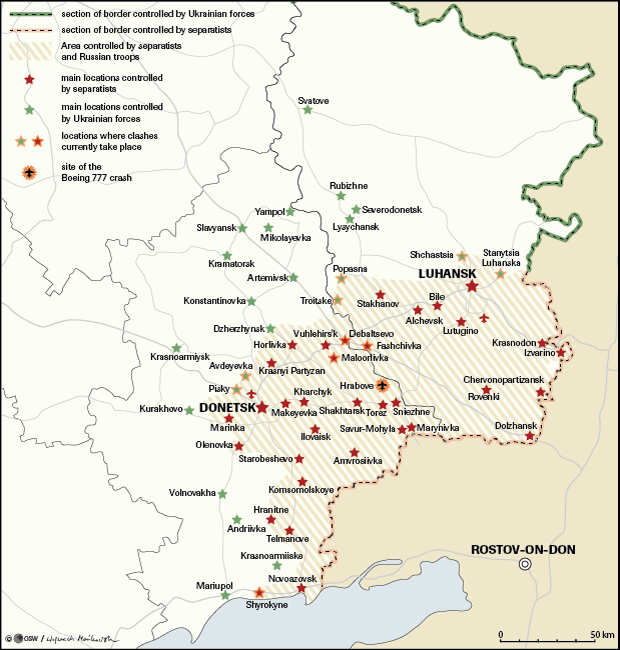‘Hybrid’ truce in the Donbas
The formal coming into force of a ceasefire at midnight on 15 February, in accordance with the agreement negotiated on 12 February in Minsk, has not stopped the fighting in the east of Ukraine. The latest clashes have primarily taken place in the area of Debaltsevo, which fell to the separatists on 18 February and from where Ukrainian units have been forced to retreat. In addition, there have been exchanges of fire in the vicinity of Donetsk, Lugansk and Mariupol. Ukraine’s situation has become very serious, and the military defeat in the Debaltsevo region will lead to a decline in the morale of the army; the public mood will deteriorate and weaken the position of the authorities in Kyiv, both domestically as well as in negotiations with Russia. Moscow, for its part, is treating the continuation of limited hostilities as an instrument for putting pressure on Ukraine and Western countries to accept its terms for the political settlement of the conflict. These assume the federalisation of Ukraine, a blockade on its integration with the EU and its permanent incorporation into the Russian sphere of influence. The UN Security Council resolution approving the Minsk agreement, which was passed on 17 February, gives Russia an additional argument based on international law in favour of imposing such a solution. As a result, neither of the parties to the conflict considers the ceasefire as permanent, and each is blaming the other for its violation.
Fighting despite the truce
The ceasefire took effect at midnight on 15 February in accordance with the truce agreements signed in Minsk on 12 February. It was preceded by two days of fierce fighting. A break in the exchange of fire lasted no longer than a few hours, after which the separatists resumed shelling Ukrainian positions in several regions simultaneously (according to the Ukrainian side, from midnight on 15 February to the morning of the 17th, the separatists fired at their positions 164 times). The vast majority of the clashes took place in the so-called ‘Debaltsevo pocket’, for control over which full-scale fighting erupted again on 16-17 February. On 18 February Debaltsevo was occupied by the separatists, and the Ukrainian command ordered its troops to retreat from their positions (there is no confirmed information at present on how this procedure passed off, or what losses were suffered). The heavy fighting in the area of Debaltsevo contrasted with the relative calm on other sectors of the front. Exchanges of fire have occurred sporadically in the areas of Donetsk (mostly in the area of the town of Pieski), Lugansk (Novotoshkovskoye and Schastie) and Mariupol (Shirokino). Both parties have declared their intention to comply with the ceasefire agreements on condition of a total halt to all attacks, while accusing each other of violating the ceasefire agreements.
The separatists have claimed that the Minsk decisions do not apply to the ‘Debaltsevo pocket’, and have arrogated to themselves the right to take control over this area (although the Minsk agreement granted this area to the Ukrainian side). The main purpose of their operation, apart from taking Debaltsevo and gaining the surrender of the Ukrainian forces defending the area, was to provoke an offensive by government forces to relieve the defending troops, which would ultimately have undermined the ceasefire agreement.
Both sides are still sending additional men and materiel to the Donbas, including to the relatively quiet areas, which suggests both parties are assuming that fighting will continue. Since the separatists have now taken the ‘Debaltsevo pocket’, the question of how long the ceasefire will remain in effect elsewhere becomes open. We should assume that the two sides are not thinking so much about maintaining the ceasefire, as about blaming their opponents for breaching its conditions.
Kyiv’s increasingly difficult position
The situation for Ukraine and its government is becoming very difficult. The losses it has incurred and the loss of the Debaltsevo region, which is of more symbolic than military importance for Ukraine, will adversely affect the morale of the army as well as the mood of the general public, and will undermine confidence in the military and political leadership of the country, including that of the president. With very limited room for political manoeuvre or chances of military success, the authorities in Kyiv are trying to win the support of international opinion, in order that it should put pressure on Moscow and bring a halt to the continuing military operations. On 15-17 February, President Poroshenko held a series of talks, including with the leaders of Germany, France and Russia (within the ‘Normandy format’) and the United States. The Ukrainian government also urged EU member states and NATO to issue a strong protest against the separatists’ violations of the ceasefire. Ukraine has consistently emphasised its willingness to abide by the Minsk agreements, and blames the separatists and Russia for violating them. At the same time the Ukrainian president is making a show of his decisiveness, principally for domestic consumption. On 14 February he threatened that if the truce was broken, he would introduce martial law in the country. Meanwhile, on 17 February the Ukrainian military command refused to withdraw its heavy weapons (according to the agreement in Minsk, that process should have begun on that day) until the ceasefire is respected. At the same time, the authorities are trying to save face; on 18 February Poroshenko went to the Donbas, where he stressed that the Ukrainian troops had withdrawn from the Debaltsevo area in an organised manner, still bearing their weapons.
Russia’s attitude
It would be impossible for the rebels to continue their military action without at least the tacit permission of the Russian side. This suggests that when the Kremlin signed the Minsk agreement on 12 February, it did so on the assumption that the agreements would reduce the Ukrainian side’s possibilities of offering armed resistance to a much greater extent than they would reduce Russian possibilities of exercising military pressure on Kyiv. Russia assumes that as long as the military action remains limited (e.g. localised to areas such as Debaltsevo), then Western capitals, especially Berlin, will – in the name of ending the fighting – put greater pressure on the Ukrainian side, prompting it to make further concessions. The Minsk agreement was also intended to prevent the US administration from deciding to give Kyiv military assistance, and block the European Union’s ability to impose new economic sanctions against Russia. Moscow is hoping that it can draw a veil over its own liability for breaching the ceasefire, while putting the blame on Kyiv for doing so.
The continuing military pressure has several aims: to gradually expand the area controlled by the rebels (who have laid claim to the whole of the Donetsk and Lugansk regions); to weaken the morale of the Ukrainian armed forces; to provoke a split among the Ukrainian political elite; and to deepen the mood of fatigue and resignation among the Ukrainian public. At the same time, the Kremlin is seeking to demonstrate the complete powerlessness of its Western European partners and force them to recognise that the establishment of a lasting peace in Ukraine will be possible only on Russian terms: the federalisation of Ukraine and the abandonment of its pro-Western course, while receiving financial assistance from the West.
From the statements President Putin made in Budapest, it can be concluded that for Russia at the first stage the most important part of the Minsk agreement is Kyiv’s commitment to undertake constitutional reform, in accordance with the demands of the Moscow-controlled separatists in the Donbas. The adoption on 17 February of UN Security Council Resolution 2202/2015, supporting the Minsk agreement (which came as an annex to the text of the resolution itself), allows the Russians to declare that these commitments have now become part of international law.
Map
Situation in eastern Ukraine (as of 18 February)






